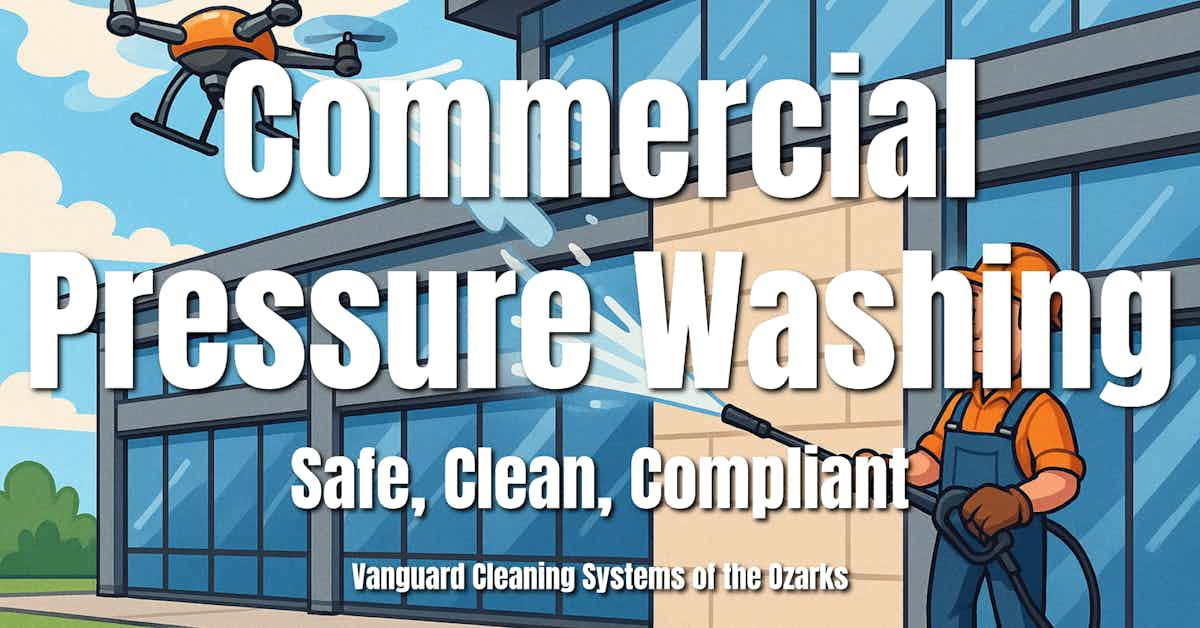Commercial pressure washing protects buildings, boosts appearance, and even aids decontamination—when done responsibly.

Introduction: Why Pressure Washing Matters
Commercial buildings represent more than physical structures. They symbolize professionalism, brand image, and long-term investment. Yet building exteriors are constantly exposed to weather, pollution, biological growth, and human interaction. Dirt, mold, algae, graffiti, and industrial residues not only degrade appearance but also pose risks to structural integrity and public health.
Commercial pressure washing has become one of the most effective maintenance strategies for restoring, preserving, and protecting building exteriors. When done correctly, it provides benefits that go far beyond curb appeal. It supports health, safety, and compliance while reducing long-term maintenance costs. But, as research shows, it also comes with risks—especially if pressure levels, chemicals, or wastewater are mismanaged.
The Benefits Of Commercial Pressure Washing
Aesthetic Improvement
Clean building exteriors project professionalism. Removing grime, graffiti, and biological growth restores surfaces to their original look, increasing customer confidence and community reputation.
Preventive Maintenance
Mold, algae, mildew, and bird droppings contain acids and organisms that slowly break down stone, brick, stucco, and paint. Pressure washing halts this process, extending the life of exterior materials.
Health And Safety
Algae and moss create slippery conditions on sidewalks, steps, and entryways. Mold and pollutants trapped on walls or windows can influence air quality indoors. Cleaning reduces these risks.
Regulatory Compliance
Certain facilities—such as healthcare buildings or food production sites—must maintain exteriors to hygiene and safety standards. Pressure washing assists in meeting these compliance requirements.
The Science Behind Pressure Washing
Decontamination Potential
Pressure washing can serve critical public health functions when paired with sporicidal disinfectants. Research shows that surfaces contaminated with spores of Bacillus anthracis can be effectively decontaminated when commercial disinfectants are applied with pressure washing. Materials tested included brick, steel, and treated wood, and the process achieved significant removal of hazardous contaminants. This positions pressure washing as more than cosmetic—it can be part of biosecurity and emergency response strategies.
Risks To Building Envelopes
Studies demonstrate that fluid pressures applied during maintenance can exceed the design tolerances of building envelopes. High-pressure streams may force water into cracks, damage protective coatings, or degrade structural seals. Over time, this can lead to moisture ingress, mold growth behind walls, or even structural compromise. Proper calibration of water pressure, nozzle design, and technician expertise are critical to prevent damage.
Removal Of Biofilms And Stubborn Soil
Not all contaminants are easily removed with water alone. Biofilms and stubborn soils resist conventional washing methods. Research confirms that effective removal often requires a combination of hot water, elevated pressures, chemical disinfectants, and mechanical abrasion. In practical terms, this means commercial washing of surfaces with algae, industrial residue, or microbial films may require specialized equipment and cleaning agents in addition to water.
Innovations In Pressure Washing
Technology is changing how buildings are cleaned. One study highlighted the use of unmanned aerial vehicles (UAVs) equipped with hydrogen fuel cells for pressure washing. These drones can reach high-rise facades safely, reducing the need for scaffolding or rope access and lowering worker risk. This innovation demonstrates the potential for safer, more sustainable cleaning of tall or complex buildings.
Practical Considerations For Facility Managers
Surface Material Sensitivity
Not all building materials can tolerate the same water pressure.
- Brick and stone: Require lower pressures to avoid cracking.
- Stucco: Easily damaged by excessive force.
- Vinyl siding: Can warp if pressure is too high.
- Concrete: Generally more durable but still requires attention to avoid etching.
Chemical Choice
The choice of detergents and disinfectants is essential. Some surfaces may require biodegradable products to minimize runoff impact, while others demand strong degreasers or sporicidal solutions. Matching chemical to soil type and substrate is vital for both safety and efficacy.
Wastewater Management
Effluent from pressure washing can carry hazardous contaminants, including biological material, chemical residues, and heavy metals from building surfaces. Without proper collection and treatment, this wastewater can enter storm drains and pollute waterways. Effective services use containment systems, filters, or reclamation technology to manage discharge responsibly.
Frequency Of Service
How often a building should be washed depends on:
- Climate: Wet or humid environments foster faster biological growth.
- Location: Urban settings with pollution require more frequent cleaning.
- Building use: Healthcare, food production, and hospitality facilities often need more rigorous schedules.
Safety Protocols
Technicians should be trained in equipment use, chemical handling, and fall protection. For high-rise buildings, adherence to OSHA standards is mandatory. UAV systems may reduce risk, but they require regulatory compliance and specialized operation skills.
Environmental And Health Impacts
Airborne Contaminant Risks
Pressure washing can release aerosols, spores, and chemical residues into the air. While cleaning removes contaminants from surfaces, it may expose workers and bystanders to particulates if containment is not managed.
Chemical Runoff
Biocides and degreasers used in washing can leach into soil and water if not properly contained. Eco-friendly alternatives help reduce risks, but runoff management remains critical.
Worker Safety
High-pressure water streams can cause injury. Proper PPE, training, and controlled pressure settings prevent accidents. UAV-based systems may significantly reduce worker exposure in the future.
Industry Trends In Pressure Washing
- Eco-Friendly Products: Demand for biodegradable detergents and reduced chemical loads is increasing.
- Water Conservation: Recycling and reclamation systems are becoming standard for sustainable operations.
- Drone-Based Washing: UAV technology is gaining traction in high-rise cleaning, reducing scaffolding needs.
- Integration With Building Maintenance Plans: Pressure washing is increasingly scheduled alongside inspections, painting, and repairs.
Best Practices For Facility Managers
- Request Pre-Assessment: Ensure the provider inspects building materials and identifies risks.
- Ask About Pressure Calibration: Verify that pressures will be adjusted based on surface type.
- Require Wastewater Control: Confirm runoff will be contained or treated.
- Insist On Proof Of Insurance: Protects against liability for accidental damage or injury.
- Schedule Regular Maintenance: Prevents buildup that requires more aggressive—and potentially damaging—methods later.
- Consider Technology Adoption: Ask whether UAV systems or eco-friendly products are part of the service.
People Also Ask (PAA)
What does commercial pressure washing include?
It includes cleaning of building exteriors such as walls, sidewalks, roofs, and windows, often with specialized detergents.
Can pressure washing damage a building?
Yes. If not properly calibrated, high-pressure water can damage surfaces, seals, and protective coatings.
How often should a building be pressure washed?
Frequency depends on climate, building use, and exposure, but most facilities benefit from annual or semi-annual washing.
Is pressure washing environmentally safe?
It can be if wastewater is properly contained and eco-friendly detergents are used. Otherwise, it risks contaminating waterways.
What new technologies are being used in pressure washing?
UAVs powered by hydrogen fuel cells are being developed for cleaning high-rise building facades safely and efficiently.
Frequently Asked Questions (FAQ)
Do all exterior surfaces require the same pressure settings?
No. Each material has different tolerance levels. Brick, stucco, and vinyl siding require lower pressure, while concrete can handle more force.
Is detergent always necessary in pressure washing?
Not always. For general dirt, water may be sufficient, but biofilms and stubborn soils often require detergents or disinfectants.
How can businesses ensure compliance with environmental regulations?
By choosing providers that use wastewater containment systems, eco-friendly products, and documented disposal practices.
Are drone-based pressure washing systems safe?
Yes, when operated by trained professionals. They reduce worker risk and can improve efficiency, though regulations vary by region.
What should facility managers look for when hiring a pressure washing service?
Experience, equipment calibration, insurance coverage, wastewater management, and sustainable practices.
Conclusion: Balancing Benefits And Risks
Commercial pressure washing is one of the most effective tools for maintaining building exteriors. It restores appearance, protects materials, reduces health hazards, and supports compliance. Research confirms that it can even serve in decontamination roles when paired with disinfectants.
At the same time, risks to building materials, environmental systems, and worker safety require careful management. High pressures can damage surfaces, chemicals can pollute, and runoff can create compliance issues. By choosing qualified providers who calibrate equipment, manage wastewater, and adopt modern technologies, facility managers can maximize benefits while minimizing risks.
The future of pressure washing lies in eco-friendly chemicals, reclamation systems, and UAV-based cleaning for safer, more efficient operations. Done responsibly, it is not just cleaning—it is preventive maintenance, risk management, and brand protection.
Vanguard Cleaning Systems of the Ozarks' franchise-owned custodial service provider business cleans more than 8M sq. ft. weekly, maintaining an industry-topping 95+% of its customer base, year-over-year, and boasting more than 60 5-star Google reviews.
Need more capability from your vendor partners? --Let's talk.
In Oklahoma, dial 918-960-4450
In Arkansas, dial 479-717-2410
In Missouri, dial 417-812-9777
References
Burfoot, D., Middleton, K., & Holah, J. (2009). Removal of biofilms and stubborn soil by pressure washing. Trends in Food Science and Technology, 20(9), 389–395. https://doi.org/10.1016/j.tifs.2009.01.042
Edmonds, J., Sabol, J., & Rastogi, V. (2014). Decontamination efficacy of three commercial-off-the-shelf (COTS) sporicidal disinfectants on medium-sized panels contaminated with surrogate spores of Bacillus anthracis. PLoS ONE, 9(6), e99827. https://doi.org/10.1371/journal.pone.0099827
Melgarejo, J., & Furukawa, R. (2022). Unmanned aerial vehicle design for pressure washing building facades in Lima Metropolitan Area using hydrogen fuel cell. 2022 IEEE XXIX International Conference on Electronics, Electrical Engineering and Computing (INTERCON), 1–4. https://doi.org/10.1109/INTERCON55795.2022.9870088
Muir, A., & Gjerde, M. (2010). Evaluation of fluid pressures applied to the building envelope during maintenance. Architectural Science Review, 53(4), 333–339. https://doi.org/10.3763/asre.2010.0026

